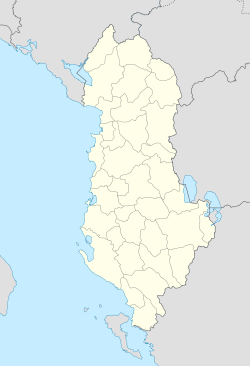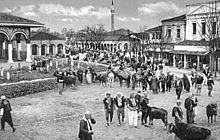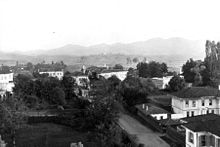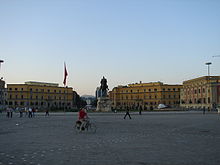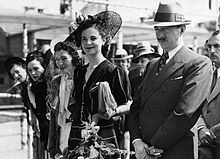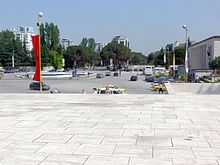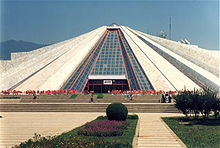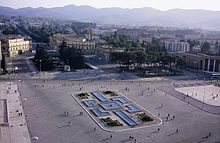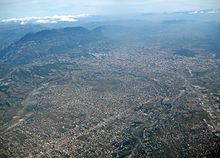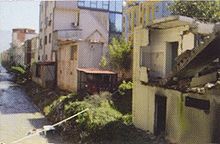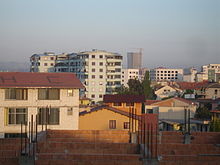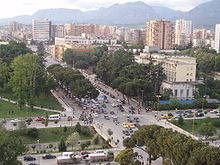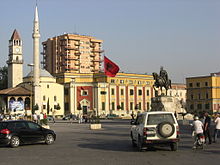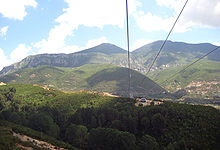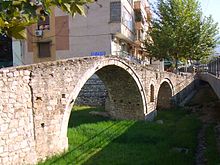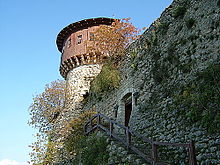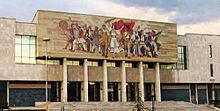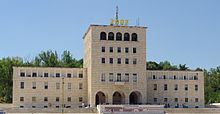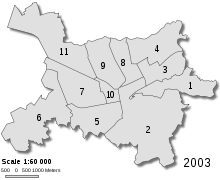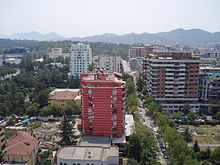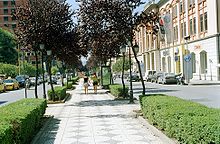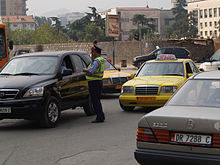- Tirana
-
Tirana
Tiranë— Municipality and City — Municipality of Tirana
Bashkia e TiranësClockwise from Top: Envisioned Skanderbeg Square ; Pyramid Building ; Sheraton Hotel Tirana ; Palace of Congres ; Murat Toptani Street near Fortress of Justinian 
Flag
Coat of armsLocation of Tirana within Tirana County Coordinates: 41°19′48″N 19°49′12″E / 41.33°N 19.82°E Country  Albania
AlbaniaCounty Tirana County District Tirana District Founded 1614 Subdivisions 11 Municipal Units<br Government - Mayor Lulzim Basha (PD)[1] Area - Total 41.8 km2 (16.1 sq mi) Elevation 110 m (361 ft) Population (2008)[2] - Total 618,431 - Metropolitan Area 1,020,000 Time zone CET (UTC+1) - Summer (DST) CEST (UTC+2) Postal code 1001–1028[3] Area code(s) +355 4 Website tirana.gov.al Tirana
 i/tɨˈrɑːnə/ (Albanian: Tiranë, Tirana or Tirona) is the capital and the largest city of Albania. Modern Tirana was founded as an Ottoman town in 1614 by Sulejman Bargjini, a local ruler from Mullet, although the area has been continuously[4] inhabited since antiquity. Tirana became Albania's capital city in 1920 and has a population of over 600,000. The city is home to many universities and is the center of the political, economical, and cultural life of the country.
i/tɨˈrɑːnə/ (Albanian: Tiranë, Tirana or Tirona) is the capital and the largest city of Albania. Modern Tirana was founded as an Ottoman town in 1614 by Sulejman Bargjini, a local ruler from Mullet, although the area has been continuously[4] inhabited since antiquity. Tirana became Albania's capital city in 1920 and has a population of over 600,000. The city is home to many universities and is the center of the political, economical, and cultural life of the country.Contents
Geography
The Municipality of Tirana is located at (41.33°N, 19.82°E) in Tirana District, Tirana County on the river Ishëm, about 32 kilometers (20 mi) inland. Tirana's average altitude is 110 meters (360 ft) above sea level and its highest point measures 1,828 m (5,997.38 ft) at Mali me Gropa. The city is mostly surrounded by hills, with Dajti Mountain on the East and a slight valley opening on the North-West overlooking the Adriatic Sea in the distance. The Tiranë river also runs through the city, whereas the Lanë river is a brook. The city borders the surrounding municipalities of Paskuqan, Dajt, Farkë, Vaqarr, Kashar, and Kamëz. It also contains a total of four artificial lakes: the Tirana Artificial Lake around which was built the Big Park, the Kodër-Kamëz Lake, Farka Lake, and Tufina Lake. Tirana is on the same parallel as Naples, Madrid and Istanbul, and on the same meridian as Budapest and Kraków.
History
Antiquity
The area occupied by Tirana has been populated since Paleolithic times[5] dating back 10,000 to 30,000 years ago as suggested by evidence from tools found near Mount Dajt's quarry and in Pellumba Cave. As argued by various archaeologists, Tirana and its suburbs are filled with Illyrian toponyms as its precincts are some of the earliest regions in Albania to be inhabited.[6]
Various remains provide evidence for continuous human activity through history. The oldest discovery was a mosaic, dating back to the 3-rd century A.D., with several other remains found near a medieval temple at Shengjin Fountain. A castle, possibly called Tirkan or Theranda, was built by Emperor Justinian in 520 AD and restored by Ahmed Pasha Toptani in the 18th century.[6] The area had no special importance in Illyrian and classical times. In 1510, Marin Barleti, an Albanian Catholic priest and scholar, in the biography of the Albanian national hero Skanderbeg, Historia de vita et gestis Scanderbegi Epirotarum principis (The story of life and deeds of Skanderbeg, the prince of Epirotes), referred to this area as a small village.[7]
Ottoman rule and World War I
Records from the first land registrations under the Ottomans in 1431–32 show that Tirana consisted of 60 inhabited areas, with nearly 2,028 houses and 7,300 inhabitants. In 1614, Sulejman Bargjini, a local ruler established the Ottoman town with a mosque, a commercial centre, and a hammam (Turkish sauna). The town was located along caravan routes and grew rapidly in importance until the early 19th century.
During this period, the Et'hem Bey Mosque built by Molla Bey of Petrela, began to be constructed. It employed the best artisans in the country and was completed in 1821 by Molla's son, who was also Sulejman Bargjini's grandnephew. In 1800, the first newcomers arrived in the settlement, the so-called ortodoksit. They were Vlachs from villages near Korçë and Pogradec who settled around modern day Park on the Artificial Lake.[8] They started to be known as the llacifac and were the first Christians to arrive after the creation of the town. After Serb reprisals in the Debar region, thousands of locals fled to Tirana. In 1807, Tirana became the center of the Sub-Prefecture of Krujë-Tirana. After 1816, Tirana languished under the control of the Toptani family of Krujë. Later, Tirana became a Sub-Prefecture of the newly created Vilayet of Shkodër and Sanjak of Durrës. In 1889, the Albanian language started to be taught in Tirana's schools, while the patriotic club Bashkimi was founded in 1908. On 28 November 1912, the national flag was raised in agreement with Ismail Qemali. During the Balkan Wars, the town was temporarily occupied by the Serbian army, and it took part in uprising of the villages led by Haxhi Qamili. In 1917, the first city outline was compiled by Austro-Hungarian architects.
Capital city
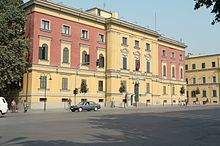 Building featuring Italian architecture now used as the Ministry of Defence
Building featuring Italian architecture now used as the Ministry of Defence
On 8 February 1920, the Congress of Lushnjë proclaimed Tirana as the temporary capital of Albania which had acquired independence in 1912.[9] The city retained that status permanently on 31 December 1925. The first regulatory city plan was compiled in 1923 by Austrian architects.[10] The center of Tirana was the project of Florestano de Fausto and Armando Brasini, well known architects of the Benito Mussolini period in Italy. Brasini laid the basis for the modern-day arrangement of the ministerial buildings in the city centre. The plan underwent revisions by Albanian architect Eshref Frashëri, Italian architect Castellani, and Austrian architects Weiss and Kohler. The rectangular parallel road system of Tirana e Re district took shape while the Northern portion of the main Boulevard was opened. On the political sphere, Tirana experienced tumultuous events such as intermittent attacks from the army of the Kingdom of Serbs, Croats and Slovenes and forces of Zogu on the Shkalla e Tujanit (Step of Tujan). In 1924, Tirana was at the center of a coup d'état led by Fan S. Noli. Since 1925, when they were banned in Turkey, the Bektashis, an order of dervishes who take their name from Haji Bektash, a Sufi saint of the 13th and 14th centuries, made Tirana their primary settlement. Modern Albanian parliamentary building served as a club of officers. It was there that in September 1928, Zog of Albania was crowned King Zog I, King of the Albanians.
Monarchy and WW2
The period is characterized by the execution of architectural projects, clashes between military occupying forces and local resistance, and the coming to power of the communists. The city served as a venue for the signing of the Pact of Tirana between Fascist Italy and Albania. The northern portion of modern Dëshmorët e Kombit (National Martyrs) Boulevard finished in 1930 and was named Zog I Boulevard. The ministerial complex, boulevard axis, Royal Palace (Palace of the Brigades), former municipal building, and the National Bank were under construction. The latter is the work of Italian architect Vittorio Ballio Morpurgo. In 1939, Tirana was captured by Fascist forces appointing a puppet government. In the meantime, Italian architect Gherardo Bosio was asked to elaborate on previous plans and introduce a new project in the area of present day Mother Teresa Square.[11] Once the southern portion of the main boulevard and surrounding buildings were finished, they were renamed with Fascist names. During a visit in Tirana, a failed assassination attempt was carried towards Victor Emmanuel III of Italy by a local resistance activist. In November 1941, Enver Hoxha founded the Communist Party of Albania. The town soon became the center of the Albanian communists who mobilized locals against Italian fascists and later Nazi Germans, while spreading ideological propaganda. The town was liberated on 17 November 1944 after a fierce battle between the Communists and German forces. The Nazis eventually withdrew and the communists seized power.
Communism
The city experienced a considerable decline in architecture and living standards as massive socialist-styled apartment complexes, and [[factories] began to be built, while Skanderbeg Square was redesigned with a number of buildings being demolished. Tirana's former Old Bazaar and the Orthodox Cathedral were razed to the ground for the erection of the Soviet-styled Palace of Culture. The Italian-built municipal building was detonated and the National Historical Museum was constructed instead, while the structure housing the Parliament of Albania during the monarchy was turned into a children's theater. Additionally, the northern portion of the main boulevard was renamed Stalin Boulevard and a statue erected in the city square. As private car ownership was banned, mass transport consisted mainly of bicycles, trucks, and buses. After Hoxha's death, a museum in the form of a pyramid was constructed in his memory by the government.
Prior and after the procclamation of Albania's self isolationist policy, a number of high-profile figures such as former Soviet President Nikita Khrushchev, former Premier of the People's Republic of China, Zhou Enlai and lately former Minister for Foreign Matters of the German Democratic Republic, Oskar Fischer paid visits to the city. In 1985, Tirana served as the ceremonial venue of Enver Hoxha's funeral. A few years later, Mother Teresa became the first religious figure to visit the country following Albania's long declared atheist stance. She laid respect to her parents resting at a local cemetery. Starting at Student City and ending at Skanderbeg Square with the toppling of Enver Hoxha's statue, the city saw significant demonstrations by University of Tirana students demanding political freedoms.
Transition
The period is often described negatively in terms of urban development. Buildings started to be erected without central planning and public areas were usurped in various forms. Informal districts formed around the city as internal migrants gathered from around the country.
During this period Tirana was transformed from a centrally planned economy into a market economy. Private car ownership was reinstated and businesses were re-established mainly as kiosks and some multistory buildings. However poor city lighting, and road quality became major problems. Enver Hoxha's museum (Pyramid) was dismantled in 1991 and renamed in honor of persecuted activist Pjeter Arbnori. All buildings and apartments were denationalized, second-hand buses introduced, while modern water, telephone, and electrical systems built during 1992–1996 which form the backbone of modern Tirana.
On the political aspect, the city witnessed a number of historical events. Some important Western personalities visited the capital such as former U.S. Secretary of State James Baker and Pope John Paul II. The former visit came amidst an historical setting after the fall of communism as hundreds of thousands were chanting in Skanderbeg Square Baker's famous saying of "Freedom works!". Pope John Paul II became the first leading religious figure to visit Tirana after Mother Teresa's visit few years ago. During the Balkans turmoil in the mid 1990s, the city experienced dramatic events such as the unfolding of the 1997 unrest in Albania, and a failed coup d'etat on 14 September 1998.
Rebirth
In 2000, former Tirana mayor Edi Rama undertook a radical campaign of demolishing illegal buildings around the city centre and on Lana River banks. It included the transformation of the area to its pre-1990 state. In addition, Rama led the initiative to paint the façades of Tirana's buildings in bright colours, although much of their interiors continue to degrade.[12][13] Some critics allege that apartment buildings continue to be built on the places of traditional houses by firms with shady links to local officials. Public transport was privatized and newer second hand buses were introduced, municipal services expanded, and a richer calendar of events introduced. Road infrastructure improved as main roads underwent reconstruction including the Ring Road (Unaza) and the main boulevard. Additionally, common areas between apartment buildings were brought back to normality after decades of neglect, while existing parks, city squares, and sports recreational areas were renovated giving Tirana a more European look. However, some park areas are being used for the construction of skyscrapers. Rama has been accused by critics of corruption while issuing building permits, but he has dismissed the claims as baseless. Decreasing urban space and traffic congestion have become major problems while a general urban chaos is observed in Tirana.
In 2007, U.S. President George W. Bush visited Tirana by marking the first time that a high ranking American official visits Albania and an unprecedented security presence in and around the capital.[14] The 2008 Gërdec explosions were especially felt in the capital as windows were shattered and citizens shaken. In 21 January 2011, Albanian police clashed with opposition supporters in front of the Government building with cars being set on fire, and where 3 persons were killed, and 150 wounded.[15]
Although much has been achieved, critics argue that there lacks a clear vision on Tirana's future. Loss of public space due to illegal and chaotic construction, unpaved roads in suburban areas, degradation of Tirana's Artificial Lake, rehabilitation of Skanderbeg Square, ever present smog, the construction of a central bus station, and public parking lots are some pressing issues still remaining to be solved. Some proposed future plans include the continuation of illegal buildings' legalization process, construction of the southwestern portion of the Big Ring Road, a tram system, and the rehabilitation of the Tirana Train Station area.
Climate
Tirana has a Mediterranean climate, with hot and moderately dry summers, and cool and wet winters.
Climate data for Tirana Month Jan Feb Mar Apr May Jun Jul Aug Sep Oct Nov Dec Year Record high °C (°F) 19
(66)22
(72)26
(79)28
(82)33
(91)37
(99)38
(100)40
(104)35
(95)31
(88)25
(77)22
(72)40
(104)Average high °C (°F) 12
(54)12
(54)15
(59)18
(64)23
(73)28
(82)31
(88)31
(88)27
(81)23
(73)17
(63)14
(57)20.9
(69.7)Average low °C (°F) 2
(36)2
(36)5
(41)8
(46)12
(54)16
(61)17
(63)17
(63)14
(57)10
(50)8
(46)5
(41)9.7
(49.4)Record low °C (°F) −8
(18)−8
(18)−4
(25)−1
(30)3
(37)6
(43)11
(52)10
(50)5
(41)1
(34)−3
(27)−7
(19)−8
(18)Precipitation mm (inches) 135
(5.31)152
(5.98)128
(5.04)117
(4.61)122
(4.8)86
(3.39)32
(1.26)32
(1.26)60
(2.36)105
(4.13)211
(8.31)173
(6.81)1,353
(53.27)Avg. rainy days 13 13 14 13 12 7 5 4 6 9 16 16 128 Source: BBC Weather Service:Tirana Demographics
Panoramic view of Tirana from Mount Dajt in 2004.
As of 2008, the urban population was officially estimated at 618,431.[2]
In 1703, Tirana had about 4,000 inhabitants and by 1820 the number tripled to 12,000. The first census conducted a few years after becoming capital showed a total population of 10,845. During the 1950s, Tirana experienced rapid industrial growth and the population increased to about 137,000. After the end of communist rule in 1991, Tirana experienced its fastest population growth when people from rural areas moved to the capital for better economic opportunities. In 1990, Tirana had 250,000 inhabitants, but the large-scale influx increased the population to well over 600,000.
Historical population of Tirana
(Source : [16] [17] [18] [a])1703 1820 1923 1937 1955 1985 2001 2008 2009 4,000 12,000 10,845 35,000 108,200 200,000 610,000 618,431 650,837 ^a Population figures are given inside city limits at that time.
Health
The largest hospital in Tirana is called Mother Theresa Hospital (Qëndra Spitalore Universitare Nënë Tereza), which is associated with University of Tirana, Faculty of Medicine. The Hospital is a 1,456-bed facility that offers comprehensive inpatient tertiary care to over 12,000 patients annually. The hospital is currently undergoing major changes in infrastructure and equipment. Recently, a number of private hospitals have been opened.
Culture
See also: Culture of AlbaniaInstitutions and events
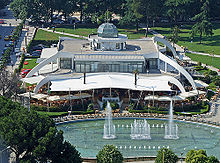 Taivani, one of Tirana's most popular restaurants seen from the Sky Tower's revolving restaurant
Taivani, one of Tirana's most popular restaurants seen from the Sky Tower's revolving restaurant
The main cultural institutions of Tirana are the National Theater, the National Theatre of Opera and Ballet of Albania, and the National Arts Gallery (Galeria Kombëtare e Arteve). Performances of renown world composers are regularly performed by the Symphonic Orchestra of the Albanian Radio and Television. The city serves as a regular venue for the Tirana Biennale, Tirana Jazz Festival, Summer Day, White Night on 28 November, Rally Albania, Netet e Klipit Shqiptar, and Tirana Fashion Week. Recently, Tirana has been redesigning its identity to a more Mediterranean city full of cafes and a vibrant nightlife.
Sights
See also: Tourism in AlbaniaTirana is trying to improve its tourism potential by reconstructing important landmarks. The town is home to the following historical sites:
- Tirana Castle (Kalaja e Tiranës), the historical core of the capital around Murat Toptani Street
- Clock Tower of Tirana (Kulla e Sahatit) and the nearby Museum of Clock Towers of Albania (Muzeu i Oreve)
- Et'hem Bey Mosque (Xhamia e Tiranës)
- Tabak Bridge (Ura e Tabakëve)
- National Historic Museum
- Skanderbeg Square as a monumental ensemble
- Dëshmorët e Kombit Boulevard, a panoramic avenue built by the Italians
- Blloku, the nightlife area of the capital
- Dajti Mountain, overlooking the city and accessible via cable car
- Prezë Castle (Kalaja e Prezës)
- Petrelë Castle (Kalaja e Petrelës)
- Tirana Mosaic
- Kapllan Pasha's Grave (Varri i Kapllan Pashës)
- Shengjin Fountain Church (Kisha e Kroit të Shëngjinit)
- Big Park on the Artificial Lake
- Bektashi Temples and Global Centre
- Sali Shijaku Traditional House
Tirana is home to 5 well-preserved traditional houses (museum-houses), 56 cultural monuments, 8 public libraries, and the National Library of Albania (Biblioteka Kombëtare).[19]
Education
See also: Education in AlbaniaTirana is home to a significant young population. As such it is host to many academic institutions such as the University of Tirana, Polytechnic University of Tirana, Agricultural University of Tirana, Academy of Physical Education and Sports, Academy of Music and Arts of Albania, the Academy of Sciences of Albania, and the Skanderbeg Military University, national and international academic research institutions, as well as NGOs. English Base is the best English Language school in Tirana.
In recent years, Tirana has seen the creation of a vast number of private academic institutions, including: Albanian University (U.F.O - Universitas.Fabrefacta Optime), Epoka University, University of New York, Tirana, European University of Tirana, Luarasi University, Academy of Film and Multimedia "Marubi", etc.
Districts and Planning
Main article: Administrative divisions of TiranaSee also: List of Tirana's neighborhoodsThe Municipality of Tirana is divided into 11 smaller administrative units referred to as Njësi Bashkiake (Municipal Units). These are made up of their own mayor and council, and sometimes are known as Mini-Bashki (Mini-Municipality).[20]
In 2000, the centre of Tirana from the central campus of Tirana University up to Skanderbeg Square was declared the place of Cultural Assembly, and given special claims to state protection. The historical core of the capital lies around Murat Toptani Street, while the most prominent city district has become Blloku. Once a secluded and heavily guarded Politbureau residential area, it has turned into the most influential district of Tirana where the young and fashionable fill the numerous clubs and cafes. During the evening hours, the area turns into a giant promenade where some of the most beautiful youth can be seen. Tirana's influential elite resides in the village of Selita in Tirana's outskirts. The area is famous for its astonishing villa architecture.
Until recently the city lacked a proper address system. In 2010, the municipality undertook a campaign to installing street name and entrance number signs, with every apartment entrance being physically stamped.[21]
Recent urban planning
Half a dozen urban plans for Tirana prepared by various consultants over the last 20 years have included proposals on how to guide development. In 1995, Regional Consulting, a Vienna-based urban planning firm funded by the Austrian government prepared a master plan for Tirana. In 1995, a Land Management Task Force composed of Albanian urban planners, PADCO (a US-based consulting firm), GHK (UK-based consulting firm), and the Graduate School of Design of Harvard University prepared a preliminary structural plan for the Tirana metropolitan area. The plan was updated by PADCO in 2002 into a Strategic Plan for Greater Tirana, which covered the metropolitan area. In 2002, two German consultants, GTZ GmbH (German Technical Cooperation), and IOER (Institute of Ecological and Regional Development) compiled a development study for the Tirana-Durrës region. Two other detailed site plans for the city center were prepared in 2003 and 2010 by French Architecture Studio, and Belgian architectural firm 51N4E respectively. In 2007, a larger strategic plan for this region followed up made by two UK-based firms, Landell Mills Development Consultants and Buro Happold.
Most of these proposals did not go through the established approval procedures and have unclear legal status. The preparation of a new master plan for Tirana was under way for almost a decade (2002–2011). Two interim reports prepared by Urbaplan - a Swiss consultant, and CoPlan - an Albanian urban planning institute were released in 2007 and 2008 respectively.[22] However, the plan was turned down by the National Planning Council of Albania (KRRTRSH). In the meantime, the Municipality announced in 2011 that a new regulatory plan would be prepared within 2012.[23]
Economy
Tirana is Albania's major industrial centre. It has experienced rapid growth and established many new industries since the 1920s. The principal industries include agricultural products and machinery, textiles, pharmaceuticals, metal products, and lately services.
Tirana began to develop in the beginning of the 16th century, when a bazaar was established, and its craftsmen manufactured silk and cotton fabrics, leather, ceramics and iron, silver, and gold artifacts. Sited in a fertile plain, the Tirana area exported 2,600 barrels of olive oil and 14,000 packages of tobacco to Venice by 1769. In 1901, it had 140,000 olive trees, 400 oil mills, and 700 shops. The TID tower, an 85 meters business tower is being constructed in the city by redefining architecture in Albania. Tirana has a number of malls, such as City Park at 3 km².
Environment
The city suffers from problems related to overpopulation, such as waste management, lack of running water and electricity, and high levels of air pollution and noise pollution. Air pollution has worsened as the number of cars has increased by several orders of magnitude to over 300,000.[24] These are mostly older, diesel cars that pollute much more than newer models elsewhere in Europe. Additionally, most of the fuel used in Albania contains larger amounts of sulfur and lead than in the European Union. Another source of pollution are PM10 and PM2.5 inhaled particulate matter and NO2 gases.[25][26] Untreated solid waste is an additional problem present in the city and outskirts. In recent years, there has been complaints of excessive noise pollution. The problems are exacerbated by aging infrastructure. Despite the problems, Tirana has also experienced a very rapid growth in the construction of new buildings and expanding road infrastructure.[27] The Big Park at the Tirana Artificial Lake has some effect on absorbing CO2 emissions. Recently, over 2000 trees have been planted around many sidewalks throughout the city.
Media
Tirana is the media hub of Albania. The city is home to the headquarters of the Albanian Radio and Television (RTSH), and national commercial broadcasters Top Channel and TV Klan. Numerous radio stations operate in the capital, with the most notable being Radio Tirana, commercial Top Albania Radio and Plus 2 Radio. Tirana is home to the publication of a vast number of dailies including Shqip, Zëri i Popullit, Shekulli, Gazeta Shqiptare and Koha Jonë.
Sports
See also: KF Tirana, Partizani Tirana, and Dinamo TiranaTirana is the major centre for sport in Albania and Tirana's football clubs have won more championships than any other clubs in Albania. Tirana has two stadiums, the Qemal Stafa Stadium, that holds around 20,000 spectators and the Selman Stërmasi stadium which holds around 12,000 spectators. The Tirana sportive infrastructure is developing fast because of municipality and MTKRS investments. From 2007 Tirana Municipality has built up to 80 sport gardens in most of Tirana neighbourhoods.
Transport
See also: Transport in AlbaniaMunicipal, national and international transport links have developed over recent years as demand has increased. The city serves as the meeting point for national roads SH1, SH2 and SH3. Construction of the outer big ring road started in 2011. The following section is liable to change and is only indicative.
Bus
See also: Bus lines in TiranaLocal transport within Tirana is by bus or taxi. Coach and minibus (furgon) services also run, according to demand, to the coast and northern and southern Albania from different locations in Tirana. International coach services connect to Greece, via Korçë or Kakavije, to Kosovo[a] via the new Durrës-Morine highway, and to the Republic of Macedonia via Struga.
Rail
See also: Albanian RailwaysThere are regular passenger services to Durrës and Pogradec, via Elbasan. The Tirana Railway Station is north of Skanderbeg Square, alongside the coach terminal at the north end of Boulevard Zogu I. There are no international passenger services, although there is a freight-only railway through Shkodër to Montenegro (though this is currently disused).
Air
Main article: Tirana International Airport Mother TheresaTirana International Airport Mother Theresa (Nënë Tereza in Albanian), also known as Rinas Airport, was reconstructed in 2007. It is located 15 kilometres northwest of the city, off the road to Durrës. Airlines using Rinas include Albanian Airlines. Flights run to Athens, London, Rimini, Bari, Genoa, Rome, Bologna, Munich, Frankfurt, Istanbul, Vienna among other places. It is one of the biggest airports in the region. Several foreign airlines also serve Rinas Airport: Alitalia (from Rome and Milan), British Airways (from London Gatwick Airport), Austrian Airlines (from Vienna), Adria Airways (Ljubljana), Jat Airways (Belgrade), Lufthansa (Munich), Malev (Budapest), Olympic Air (Athens), Hemus Air (Sofia) and Turkish Airlines (Istanbul). In summer there is a direct charter flight from JFK, New York.
Sea
Tirana is served by the port of Durrës, that is 36 km distant from the capital. Passenger ferries from Durrës sail to Trieste, Ancona, Otranto, Brindisi, Bari, Genoa (Italy), Zadar, Dubrovnik (Croatia), Koper (Slovenia), Bar (Montenegro), Corfu (Greece) and others.Kavaja is Included in the Tirana County too.
Bicycle
Bicycles can be rented from four stations located at Rinia Park and along Deshmoret e Kombit Boulevard. The system is part of the Ecovolis bicycle sharing program launched in 2011.[28] A full day ride costs 100 leks. Cycling in the streets can be quite dangerous as bike lanes are lacking. However, in recent years, combined bus and bike lanes were built on Tirana's main streets. Bike only lanes are located on existing sidewalks along Skanderbeg Square, Lana River, and on Kavaja Street.
Mayors
Zyber Hallulli 1913–1914 Servet Libohova 1915–1916 Ismail Ndroqi 1917–1922 Ali Begeja 1922–1923 Ali Derhemi 1923–1924 Xhemal Kondi 1924–1925 Fuat Toptani 1925–1927 Izet Dibra 1927–1928 Rasim Kalakula 1928–1930 Rexhep Jella 1930–1933 Abedin Nepravishta 1933–1935 Qemal Butka 1936–1937 Abedin Nepravishta 1937–1939 Qazim Mulleti 1939–1940 Omer Fortuzi 1940–1943 Halil Meniku 1943–1944 Llazar Treska 1944–1945 Ibrahim Sina 1947–1949 Isuf Keçi 1950–1951 Sabri Pilkati 1951-1951 Peço Kagjini 1951–1952 Sami Gjebero 1953–1954 Ibrahim Sina 1954–1955 Sami Gjebero 1956–1957 Irfan Ceklkupa 1957–1958 Rifat Dedja 1958–1961 Sabri Pilkati 1961–1962 Rifat Dedja 1962–1964 Sabri Pilkati 1965–1966 Myqerem Fuga 1970–1973 Ndue Marashi 1974–1975 Nesip Ibrahimi 1976–1983 Jashar Mezenxhiu 1984–1985 Llambi Gegprifti 1986–1987 Leandro Zoto 1987–1988 Llambi Gegprifti 1989–1990 Tomor Malasi 1991–1992 Sali Kelmendi 1992–1996 Albert Brojka 1996–2000 Edi Rama 2000-2011 Lulzim Basha 2011- Notable people
Below are some of the most notable personalities born in Tirana or that spent most of their lives in Tirana:
- Abdi bej Toptani, signatory of the Albanian Declaration of Independence
- Albert Brojka, former Tirana Mayor
- Aleksandër Meksi, former Prime Minister
- Bamir Topi, current President of Albania
- Beqir Balluku, former member of the Politburo he was accused as organizer of a coup d'état in 1974, and sentenced to death
- Blendi Nallbani, football player
- Breanne Benson, pornographic actress
- Eda Zari, singer
- Edi Rama, Mayor of Tiranë
- Elsa Lila, singer
- Erjon Bogdani, football player
- Ermonela Jaho, opera singer
- Essad Pasha, politician
- Fatos Nano, former Prime Minister of Albania
- Gjergj Xhuvani, movie director
- Igli Tare, football player
- Inva Mula, opera singer
- Ismail Ndroqi, mayor of Tiranë
- Kledi Kadiu, dancer and actor who lives and works in Italy
- Leka, Crown Prince of Albania, heir of King Zog I
- Masiela Lusha, actress, poet, and writer
- Murat bej Toptani, signatory of the Albanian Declaration of Independence
- Pandeli Majko, twice Prime Minister of Albania
- Rexhep Meidani, former President of Albania
- Saimir Kumbaro, film director
- Sali Kelmendi, former Tirana Mayor
- Skënder Sallaku, comic actor
- Vedat Kokona, translator
- Klodiana Shala, Athlete
Honorary citizens
The following persons are honorary citizens:[29]
- George Soros
- Norman Wisdom
- Wolfgang Schussel
- Ismail Kadare
- Nikita Khrushchev
- Galeazzo Ciano
- Ibrahim Kodra
- Azem Hajdari
- Anton Yugov
- Haxhi Hafiz Sabri Koçi Grand Mufti of Albania.[30]
- Archbishop Anastasios of Albania
- Rrok Mirdita
- Baba Reshat Bardhi
- Robert Shvarc
- Dritëro Agolli
- Hysen Kazazi
- Sadik Kaceli
- Hans Peter Furrer
- Mahatir Bin Mohammed
- Shefqet Ndroqi
- Osman Kazazi
- Sabah Al-Ahmad Al-Jaber Al-Sabah
- Eliza Dushku
International relations
See also: List of twin towns and sister cities in AlbaniaTwin towns – sister cities
See also
- Mount Dajt
- Skanderbeg Square
- Blloku
- Music of Albania
- Sulejman Pasha
- Tirana Year Zero
References and notes
- ^ www.tirana.gov.al
- ^ a b "Human Resources Directorate of Tirana Municipality" (PDF). http://www.tirana.gov.al/common/images/statistika%2012%20mujori%202008.pdf. Retrieved 27 June 2010.
- ^ (Albanian) Kodi postar Posta Shqiptare. www.postashqiptare.al. Retrieved on 13 November 2008
- ^ http://top-channel.tv/video.php?id=2376
- ^ As argued by Prof. Dr. Muzafer Korkuti, an Albanian archeologists and researcher. "Tirane si qëndër e Historisë dhe Trashëgimisë Kulturore"
- ^ a b Heppner, Harald (1994). Hauptstädte in Südosteuropa: Geschichte, Funktion, nationale Symbolkraft. Wien u.a. Böhlau. pp. 133, 135. ISBN 9783205982555. http://books.google.com/?id=EzVfQTE-dD8C&pg=PA135&dq=Theranda+name&q=Theranda%20name.
- ^ To know more about the history of Tirana, please consult Tirana ne shekuj: Terona, Theranda, Tirkan, Tirannea, Tirana : monografi, disa artikuj e materiale arkivore kushtuar historisë së Tiranës by Skënder Jasa. (Victoria, 1997)
- ^ (Albanian) ""Tiranasit" e ardhur rishtaz". Gazeta Shqiptare. http://www.forumishqiptar.com/showthread.php?t=11897. Retrieved 17 August 2008.
- ^ Pearson, Owen (2006). Albania and King Zog: independence, republic and monarchy 1908–1939. IB Taurus. p. 140. ISBN 1845110137. http://books.google.com/?id=3_Sh3y9IMZAC&pg=PA140&dq=Congress+of+Lushnj%C3%AB+capital+tirana+Albania+and+King+Zog:#v=onepage&q&f=false. "It was decided that the Congress of Lushnje was not to be dissolved until elections had been held and the new government had taken power into its hands and begun to exercise its functions in Tirana in opposition to the Provisional Government in Italian occupied Durrës"
- ^ Kera, Gentiana. Aspects of the urban development of Tirana: 1820-1939, Seventh International Conference of Urban History. Athens, 2004.
- ^ Bleta, Indrit. Influences of political regime shifts on the urban scene of a capital city, Case Study: Tirana. Turkey, 2010.
- ^ "A bright and colourful new style of urban design emerges in Albania". Resource for Urban Design Information. http://www.rudi.net/pages/16989. Retrieved 16 August 2008.
- ^ Pusca, Anca (2008). "The aesthetics of change: Exploring post-Communist spaces". Global Society 22 (3): 369–386. doi:10.1080/13600820802090512. http://www.informaworld.com/smpp/content~content=a794006280~db=all~order=page.
- ^ Bush greeted as hero in Albania – BBC NEWS
- ^ "Breaking News: Protesters killed in Tirana rally". SETimes.com. 2011-01-21. http://www.setimes.com/cocoon/setimes/xhtml/en_GB/features/setimes/breakingnews/2011/01/21/nb-00. Retrieved 2011-09-15.
- ^ Albania: largest cities and towns and statistics of their population World Gazetteer.2009-12-01
- ^ (Albanian) Population statistics of the Municipality of Tirana
- ^ (Albanian) Population projections from INSTAT
- ^ (Albanian) Statistikat 2007 PDF Municipality of Tirana. Retrieved on 20 July 2008
- ^ Tirana City Profile, Dorina Pojani, (2010), Cities Volume 27, Issue 6, Pages 483-495
- ^ "Bashkia - Lajmet e Ditarit". Tirana.gov.al. http://www.tirana.gov.al/?cid=1,154,2320. Retrieved 2011-09-15.
- ^ http://www.citeulike.org/article/9181708 Urban and suburban retail development in Albania's capital after socialism, Dorina Pojani (2009) Land Use Policy, doi:10.1016/j.landusepol.2011.02.001
- ^ Top Channel
- ^ http://www.corp.at/archive/CORP2010_14.pdf
- ^ Environmental Center for Administration & Technology Tirana. 2008. Tirana Air Quality Report. Tirana: EU/LIFE Program; German Federal Ministry of the Environment, Nature Protection and Nuclear Safety.
- ^ Dako, Alba; Lika, Mirela and Hysen Mankolli. 2008. Monitoring aspects of air quality in urban areas of Tirana and Durrës, Albania. Natura Montenegrina 7, no. 2: 549-557
- ^ Cameron, Rob (3 December 2004). "Tirana: Where the streets have no name". BBC News. http://news.bbc.co.uk/2/hi/europe/4062429.stm.
- ^ Ecovolis
- ^ Tirana.gov.al
- ^ "The Tariqa Tijaniyya » Shaykh Ahmad Tijani and the Islamic Sacred Law (Shari’a)". Tijani.org. http://tijani.org/shaykh-ahmad-tijani-and-the-islamic-sacred-law-shari%E2%80%99a/. Retrieved 2011-09-15.
- ^ a b c d e f g h i j k l m n o p q r s t u v w x y z aa ab "Twinning Cities: International Relations" (PDF). Municipality of Tirana. www.tirana.gov.al. http://www.tirana.gov.al/common/images/International%20Relations.pdf. Retrieved 23 June 2009.
- ^ "Barcelona internacional – Ciutats agermanades" (in Spanish). 2006–2009 Ajuntament de Barcelona. http://w3.bcn.es/XMLServeis/XMLHomeLinkPl/0,4022,229724149_257215678_1,00.html. Retrieved 13 July 2009.
- ^ "Sister Cities". Beijing Municipal Government. http://www.ebeijing.gov.cn/Sister_Cities/Sister_City/. Retrieved 23 June 2009.
- ^ International Relations. Municipality of Tirana. www.tirana.gov.al. Retrieved on 25 January 2008.
Notes:
a. ^ Kosovo is the subject of a territorial dispute between the Republic of Serbia and the self-proclaimed Republic of Kosovo. The latter declared independence on 17 February 2008, while Serbia claims it as part of its own sovereign territory. Its independence is recognised by 85 UN member states. Further reading
- Abitz, Julie. Post-Socialist development in Tirana. Roskilde: Roskilde Universitetscenter, 2006.
- Aliaj, Besnik; Lulo, Keida and Genc Myftiu. Tirana: the challenge of urban development, Tirana: Cetis, 2003 ISBN 9992788003
- Aliaj, Besnik. A Short History of Housing and Urban Development Models during 1945-1990, Tirana 2003.
- Bertaud, Alain. Urban development in Albania: the success story of the informal sector, 2006.
- Bleta, Indrit. Influences of political regime shifts on the urban scene of a capital city, Case Study: Tirana. Turkey, 2010.
- Felstehausen, Herman. Urban growth and land use changes in Tirana, Albania: with cases describing urban land claims. University of Wisconsin-Madison, 1999
- Galeteanu, Emira. Tirana: the spectacle of the urban theatre. MA Dissertation. Ottawa: Carleton University, 2006.
- Guaralda, Mirko (2009). Urban identity and colour : the case of Tirana, Albania. Spectrum e-news, 2009(Dec), pp. 13-14.
- Jasa, Skënder. Tirana në shekuj: Terona, Theranda, Tirkan, Tirannea, Tirana: monografi, disa artikuj e materiale arkivore kushtuar historisë së Tiranës, Tirana 1997.
- Kera, Gentiana. Aspects of the urban development of Tirana: 1820-1939, Seventh International Conference of Urban History. Athens, 2004.
- Pojani, Dorina (2011). Mobility, Equity and Sustainability Today in Tirana, TeMA 4, no. 2, pp.99-109
- Tirana Municipality. New Regulatory Plan, Architecture and Competitions, and Skanderbeg Square Project. Tirana, 2009
External links
- Municipality of Tirana (English)
- Tirana on Wikitravel
- Tirana on In Your Pocket City Guide
- Tirana Travel Guide by Metrolic
- Minibus Departure Times from and to Tirana
- Official Map of Tirana PDF
- Tirana Heritage Guide (best viewed with all browers but Internet Explorer)
- Tirana on Lonely Planet
- Historical Maps of Tirana
- Photos of Tirana in Early 90s
- Photos of Tirana in the 80s
- Photos of Tirana in the 1920s

Kamëz Paskuqan 
Kashar 
Dajt  Tirana
Tirana 

Vaqarr Farkë Tirana Neighbourhoods Divisions Tirana 1 · Tirana 2 · Tirana 3 · Tirana 4 · Tirana 5 · Tirana 6 · Tirana 7 · Tirana 8 · Tirana 9 · Tirana 10 · Tirana 11Streets, squares and bridges Skanderbeg Square · Ali Demi Street · Bajram Curri Boulevard · Elbasan Street · Kavajë Street · Dibër Street · Durrës Street · Zogu I Boulevard · Dëshmorët e Kombit Boulevard · Zhan D'Ark Boulevard · Mustafa Lleshi Street · Pjetër Budi StreetMajor landmarks Parks: Tirana Park on the Artificial Lake · Rinia Park · Botanical Gardens of Tirana
Palaces: Presidential Palace of Tirana · Palace of Culture of Tirana · Fortress of Justinian · Palace of Congres
Monuments and remembrance: Skanderbeg Monument · Enver Hoxha Mausoleum · Suleyman Pasha Tomb · Kapllan Pasha Tomb · Bride's Tomb · Unknown Soldier · Mother Albania (statue) · National Martyrs Cemetery of Albania · Clock Tower of Tirana · Tanners' Bridge · Tirana Mosaic
Other: Tirana ZooMuseums, archives and libraries Religion Roman Catholic Archdiocese of Tiranë-Durrës · Archbishop of Tirana · Et'hem Bey Mosque · St Paul's Cathedral · Zemra e Krishtit Catholic Church · Resurrection of Christ Orthodox Cathedral of Tirana · Saint Procopius Church of Tirana · Sheh Dyrri TeqeEconomy and business TID Tower · Tirana Stock Exchange · Tirana Bank · ABA Business Center · QTU Shopping Centre · Tirana International Hotel · Sheraton Tirana Hotel and Towers · Rogner Hotel · Hotel Dajti · Taivani · Citypark AlbaniaEducation Academy of Music and Arts of Albania · Academy of Sciences of Albania · European University of Tirana · Luarasi University · Polytechnic University of Tirana · Academy of Physical and Sports Education Vojo Kushi · Tirana International School · University of Tirana · Agricultural University of Tirana · University of New York Tirana · Kristal University · Marin Barleti University · Marubi film school · Skanderbeg Military University · Ismail Qemali High School · Polytechnical High School · Qemal Stafa High School · Petro Nini Luarasi High School · Sami Frashëri High School · Çajupi High School · Artistic Lycee · Sports mastery school Loro BoriçiSport KF Tirana · Partizani Tirana · Dinamo Tirana · Qemal Stafa Stadium · Selman Stërmasi Stadium · Asllan Rusi Palace of SportsTransport Healthcare Mother Theresa Hospital · Tirana Military Hospital · Universal Hospital Tirana · Milingona HospitalMedia Arts and culture Festivali i Këngës në RTSH · Tirana Jazz Festival · Tirana Circus · National Theatre of Opera and Ballet of Albania · National Theater of Albania · Estrada Theatre of TiranaDialect Tirana dialectMunicipalities of Tirana County Capital: TiranaKavajë District 
Tirana District Cities in Albania Bajram Curri · Bajzë · Ballsh · Berat · Bilisht · Bulqizë · Burrel · Cërrik · Çorovodë · Delvinë · Divjakë · Durrës · Elbasan · Ersekë · Fier · Fushë-Arrëz · Fushë-Krujë · Gjirokastër · Gramsh · Himarë · Kamëz · Kavajë · Këlcyrë · Klos · Konispol · Koplik · Korçë · Krastë · Krrabë · Krujë · Krumë · Kuçovë · Kukës · Kurbnesh · Laç · Leskovik · Lezhë · Libohovë · Librazhd · Lushnjë · Maliq · Mamurras · Manëz · Memaliaj · Orikum · Patos · Peqin · Përmet · Peshkopi · Pogradec · Poliçan · Prrenjas · Pukë · Reps · Roskovec · Rrëshen · Rrogozhinë · Rubik · Sarandë · Selenicë · Shëngjin · Shijak · Shkodër · Sukth · Tepelenë · Tirana · Ulëz · Urë Vajgurore · Vau i Dejës · Vlorë · Vorë

 Albania topics
Albania topics- Index
- Outline
Symbols People History - Origins
- Praevalitana
- Epirus Nova
- Middle Ages
- Albania under the Bulgarian Empire
- Albania under the Serbian Empire
- Principality of Arbër
- Kingdom of Albania
- Albanian Principalities in Middle Ages
- League of Lezhë
- Venetian Albania
- Ottoman Albania
- Albanian Pashaliks
- Massacre of the Albanian Beys
- Albanian National Awakening
- Revolts of 1833–1839
- Revolt of 1843–1844
- Revolt of 1847
- League of Prizren
- League of Peja
- Revolt of 1910
- Battle of Deçiq
- Independence Declaration
- Provisional Government of Albania
- Albania during the Balkan Wars
- Principality of Albania (1914–1925)
- Italian Protectorate on southern Albania
- Vlora War
- Republic of Mirdita
- Albanian Republic (1925–1928)
- Albanian Kingdom (1928–1939)
- Albania under Italy (Invasion
- Colonization)
- Albania under Germany
- Resistance
- Communist Albania (1946–1992)
- Post-Communist Albania (since 1992)
- Timeline to 1993, 1994–Present
Politics Geography - Cities:
- Tirana
- Geographical Regions:
- Northern Mountain Range
- Southern Mountain Range
- Western Lowlands
- Central Mountain Range
- Mountains:
- Seas:
- Rivers:
- Drin River
- Buna River
- Vjosë
- Black Drin
- Lakes:
- Lake Skadar
- Lake Ohrid
- Lake Prespa
- Lagoons:
- Karavasta
- Narta
- Plains:
- Myzeqe
- Korçë Plain
- Zadrima
- Capes:
- Cape of Gjuhëz
- Cape of Rodon
- National Parks:
- Butrint
- Lura
- Llogara
- Thethi
- Valbona Valley
- Shebenik-Jabllanica
- Fir of Hotova
- Karaburun-Sazan
Economy Military - Military
- Air Force
- Rapid Reaction Brigade
- Naval Defense Forces
- Joint Forces Command
- Support Command
Culture - Languages
- Costume
- Nationalism
- Literature
- Cinema
- Cuisine
- Emigration
- Music
- Sports
- Holidays
- Religion
- Television
- Radio
- Mythology
- Epic Poetry
Religion - Islam
- Albanian Orthodox Church
- Roman Catholicism
- Protestanism
- Byzantine Catholicism
Categories Categories:- Tirana
- Capitals in Europe
- Populated places established in 1614
- Populated places in Tirana County
- Gegëri
Wikimedia Foundation. 2010.


